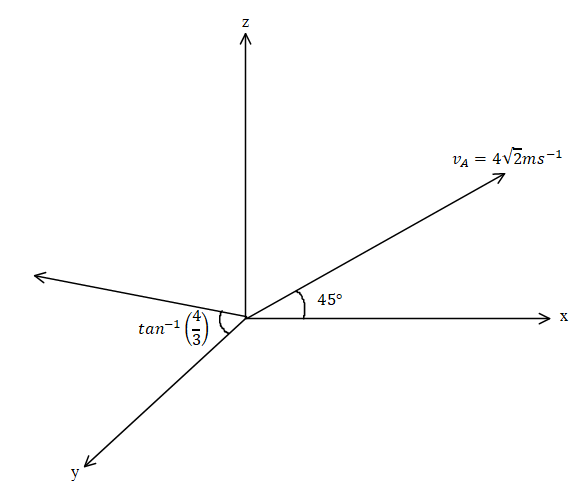Question
Question: Take the z=axis as vertical and the x-y plane as horizontal. A particle ‘A’ is projected with veloci...
Take the z=axis as vertical and the x-y plane as horizontal. A particle ‘A’ is projected with velocity 42ms−1 making an angle 45∘ to the horizontal. Particle B is projected at 5ms−1 an angle θ=tan−1(31) to y axis in y-z plane then velocity of B wrt A.
A) Has its initial magnitude5ms−1.
B) Magnitude will change with time.
C) Lies in the xy plane.
D) Will initially make an angle(θ+2π).
Solution
The x,y and z are the three directions which are mutually perpendicular to each other, the particle A is in plane x-z and the particle B is in the plane y-z. The relative velocity is the difference between the velocities of the two bodies.
Formula used:
The relative velocity of the two particles is given by,
⇒vB−vA
Where the velocity of particle B is vB and the velocity of particle A isvA.
Complete step by step solution:
In this problem it is given that a particle ‘A’ is projected with velocity 42ms−1 making an angle 45∘ to the horizontal. Particle B is projected at 5ms−1 an angle θ=tan−1(31) to y axis in y-z plane then we need to find the velocity of B wrt A.
According to the condition the figure will be.

The velocity of particle A is vA=4i^+4k^ and the velocity of particle B is equal to vB=3j^+4k^.
The relative velocity of the particle B with respect to particle A is equal to,
⇒vB−vA=(3j^+4k^)−(4i^+4k^)
⇒vB−vA=3j^+4k^−4i^−4k^
⇒vB−vA=3j^+4k^−4i^−4k^
⇒vB−vA=3j^−4i^
The magnitude of the velocity is equal to,
⇒vB−vA=32+42
⇒vB−vA=9+16
⇒vB−vA=25
⇒vB−vA=5ms−1
Which means option A is correct. The magnitude of the acceleration will not change with time and therefore the option B is wrong.
The relative velocity is vB−vA=3j^−4i^ which means it is in the x-y plane, the option C is also correct. The angle of the initially equal to,
⇒θ=tan−1(−34)
As the angle is negative and therefore we add 2π so the angle becomes θ+2π, so the option D is correct.
The wrong option is option B, so the answer for this problem is option B.
Note: The students are advised to remember the formula of the relative velocity and also the diagram of the velocity of the particle A and particle B should be drawn very carefully as the answer is very dependent on the diagram.
